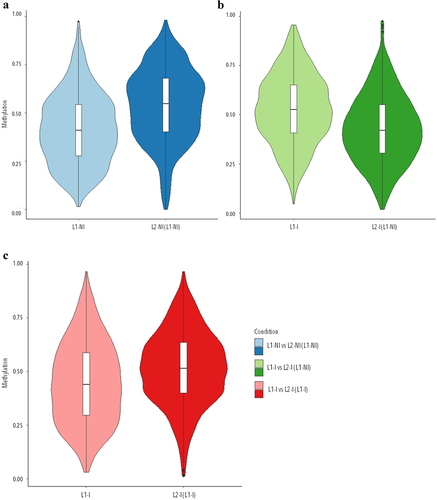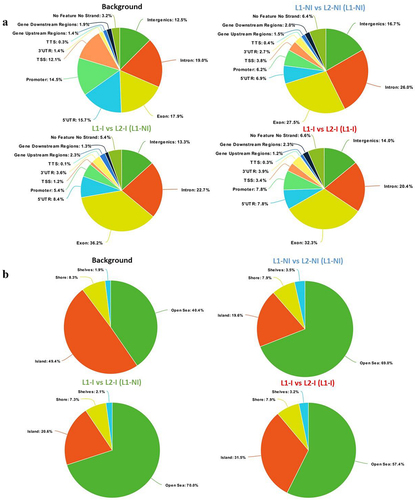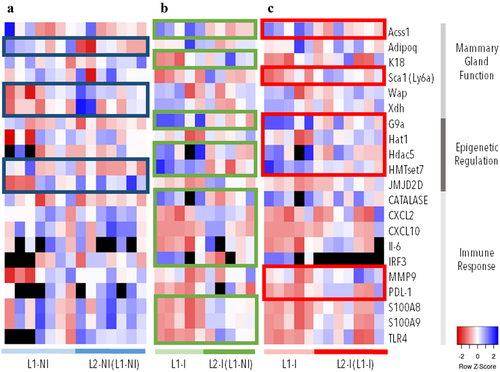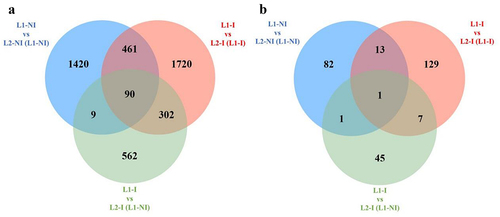Figures & data
Table 1. The total number of DMCs and DMRs and the per cent upmethylation found in all three comparisons: 1st lactation (n = 7) vs. 2nd lactation (n = 7) (blue), 1st lactation (n = 5) vs. 2nd lactation with inflammation (n = 5) (green), and 1st lactation (n = 5) vs. 2nd lactation with inflammation and previous inflammation history (n = 7) (red).
Figure 1. Violin plots of the overall distribution of methylation levels in all three comparisons: 1st lactation (n = 7) vs. 2nd lactation (n = 7) (blue), 1st (n = 5) vs. 2nd lactation with inflammation (n = 5) (green), and 1st (n = 5) vs. 2nd lactation with inflammation and previous inflammation history (n = 7) (red). The abscissa represents the different conditions in each comparison, the ordinate represents the level of methylation of the DMCs in that condition, and each violin represents the density of the point at that methylation level.

Figure 2. Pie charts showing the distribution of DMCs for all three comparisons: 1st lactation (n = 7) vs. 2nd lactation (n = 7) (blue), 1st (n = 5) vs. 2nd lactation with inflammation (n = 5) (green), and 1st (n = 5) vs. 2nd lactation with inflammation and previous inflammation history (n = 7) (red). Distribution is shown according to gene regions (a), CpG density (b), and repeats (c). All three comparisons are discussed in comparison to the background (control comprised of all CpGs found after RRBS analysis).

Table 2. Molecular function and biological processes GO (gene ontology) terms (MF: molecular function; BP: biological process) as well as signalling pathways enriched by DAVID analysis for all three comparisons: 1st lactation (n = 7) vs. 2nd lactation (n = 7) (blue), 1st lactation (n = 5) vs. 2nd lactation with inflammation (n = 5) (green), and 1st lactation (n = 5) vs. 2nd lactation with inflammation and previous inflammation history (n = 7) (red).
Figure 3. Gene expression (∆∆Ct) in three comparisons: 1st (n = 7) vs. 2nd lactations in physiological conditions (n = 7) (blue), 1st (n = 5) vs. 2nd lactations with inflammation (n = 5) (green), and 1st (n = 5) vs. 2nd lactations with inflammation and previous inflammation history (n = 7) (red). The expression of 60 genes was analysed. The genes listed in this figure are differentially expressed (p < 0.05) in at least one comparison (colour-coded rectangles). Each column represents one individual. Lowest gene expression is represented in blue (highest ∆∆Ct values), highest – in red (lowest ∆∆Ct values), no data available – in black.

Figure 4. Venn diagrams of the total number of differentially methylated cytosines (DMCs) as well as shared DMCs in three comparisons: 1st lactation (n = 7) vs. 2nd lactation (n = 7) (blue), 1st (n = 5) vs. 2nd lactation with inflammation (n = 5) (green), and 1st (n = 5) vs. 2nd lactation with inflammation and previous inflammation history (n = 7) (red) (a), as well as the total number of differentially methylated regions (DMRs) and shared DMRs in all three comparisons (b).

Supplemental Material
Download Zip (1,014.9 KB)Data availability statement
RRBS fastq files have been deposited in the European Nucleotide Archive (ENA) at EMBL-EBI under accession number PRJEB57878 https://www.ebi.ac.uk/ena/data/view/PRJEB57878.
